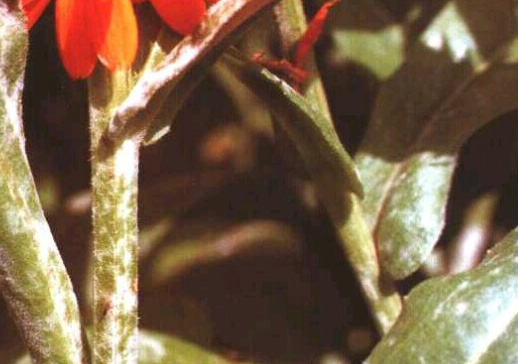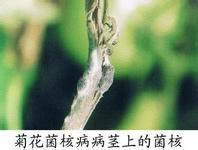ascus Learn more about ascus
-
Ganoderma lucidum disease: verrucous spore brown ground bowl fungus

Alternaria alternata (PezizabadiaPers.) It belongs to the subphylum ascomycetes, Arteriacea, Sphaeroptera, Armillariaceae. 1. Morphological characteristics: ascus bowl-shaped, sessile, dark brown, 3-6 cm wide. The ascus is cylindrical in the upper part, tapering downward into a stalk. The spores are arranged in a single row in the upper part of the ascus, oval, with obvious small sunken process. The side wire is light yellow. two。 The law of disease: (1) the spores are transmitted by air flow and wind, and the disease can also be caused by the introduction of culture material and covered soil. (
2019-01-15 -
Rotten skin of Pinus koraiensis

[distribution and harm] the disease occurred in Korean pine (Pinuskoraiensis) plantations in three northeastern provinces. Yanji, Hunchun, Helong, Wangqing, Dunhua, Antu, Longjing and other cities (counties) in Yanbian area of Jilin Province had a serious disease, with a general incidence of 20% to 30%, a seriously diseased forest of 50% to 60%, and a few stands of Maoershan Forest Farm in Yanji City, with an incidence as high as 98.6%. The pathogen invaded the phloem and cambium of the stems and lateral branches of young Korean pine trees, and even reached the surface xylem of sapwood, causing brown rot in the tissue.
2019-01-15 -
Stand alone and stand upright-- the culture method of cedar

Stand alone and stand upright-- the culture method of cedar
2019-02-22 -
needle drop disease of Korean pine

Needle drop disease of Pinus koraiensis is a common disease worldwide. The disease can infect from young trees to big trees, causing early defoliation, affecting growth and causing the death of diseased plants. Symptoms: The disease usually affects 2-year-old needles, and some 1-year-old needles can also be affected. At the beginning of the disease, small yellow spots or segmental spots were produced on the infected needles, and the whole leaves turned yellow and fell off in late autumn. In the spring of the following year, large, black or gray, long oval or elliptical protruding grains appeared on the infected needles, with paint luster and a longitudinal crack in the center, which were asci disks of pathogenic fungi. Some diseased leaves
2019-01-15 -
Harm and control of powdery mildew of Angelica sinensis

The pathogen of powdery mildew of Angelica sinensis (ErysipheSP.) belongs to ascomycetes subphylum powdery mildew. The closed capsule accumulates and is buried in the mycelium, spherical or oblate, black or dark brown. The obturator shell contains 6 sub-cysts of 3 Mel. The ascus is subglobose, ovate, colorless, short stalked, thick membrane, and contains 6 ascospores. Ascospores are oval, colorless and transparent, unicellular. The main results are as follows: 1. the harmful symptom is harmful leaves. At the initial stage of the disease, gray-white powdery spots appeared on the leaf surface, and then enlarged and converged into large spots.
2019-01-15 -
How does impatiens suffer from powdery mildew?

[distribution] it happens all over the week. [symptoms] the disease mainly occurs on leaves and shoots, and seriously harms buds and capsules. The disease began in Beijing after June, and after July, the leaf surface was gradually covered with white powder layer, and gradually expanded to the whole leaf covered with white powder layer. In the later stage, yellow dots were formed on the powder layer, and the color gradually deepened and became dark brown, which was the closed capsule of the pathogen and was spherical under the magnifying mirror. The dark brown dots mainly appeared on the front of the leaves and the small dots on the back of the leaves were rare. In severe cases, the leaves withered and fell early. Shanghai is generally in bloom.
2019-01-16 -
Impatiens powdery mildew and brown spot

Powdery mildew symptoms: mainly harm leaves, flowers and stems can also be damaged. Round white mildew spots first appeared on the leaves of impatiens, which generally began to occur in May. After June, the disease spots expanded or multiple disease spots were connected into pieces, each layer thickened to form a white powdery mildew layer, and mildew layers could be produced on the front and back of the leaves. In early autumn, yellow dots were formed in the powder layer, and then gradually deepened and finally dark brown. In serious cases, the leaves died and fell early. Pathogen and occurrence regularity: the subphylum of atomic cysticercus, powdery mildew caused by monofilament. Son
2019-01-16 -
cotton seedling anthracnose

Symptoms can occur in seedling stage and adult plant stage. After seedling stage, the disease can cause seed rot before germination; after emergence, reddish brown crack spots occur at the base of stem, expanding contraction causes seedling death. Orange slime (conidia) is produced on the spots when wet. The cotyledon edge appears round or semicircular chloasma, after drying off the cotyledon edge incomplete. Cotton bolls were dark red spots in the early stage of infection, brown spots after expansion, depression of the disease, orange powder that is, conidia. Serious when the whole bell rot, can not crack, fibers become black
2019-01-16 -
Harm and Control of Common miscellaneous bacteria in Edible Fungi

First, Alternaria. Also known as Neurospora. The asexual stage belongs to Trichoderma, Chlamydomonaceae; the sexual stage is a kind of ascomycetes. Pleurotus ostreatus is harmful to Alternaria crassa and Alternaria alternata. Hyphae white, lax, branched and septate. The conidiophores are bifurcated. Conidia series, globose to ovoid, orange or pink. Vesicles fascicled or scattered, subglobose or ovate. The ascus is cylindrical and contains 8 ascospores. Alternaria is widely distributed and can be spread in air, soil, rotten plants, grains and so on. The culture material is too wet and
2019-01-16 -
Spruce snow blight

[distribution and harm] Foreign countries are distributed in North America, Northern Europe and Central Asia, harming European spruce (Piceaabies), white spruce (P.glauca), black spruce (P.mariana) and so on. It is distributed in Tianshan Mountain, Altai Mountain, Western Junggar Mountain and Kunqu Mountain in China. Damage to spruce (P.schrenkiana), Siberian spruce (P.obovata), Qinghai spruce (P.crassifolia) and Sichuan spruce (P.balfouria7)
2019-01-16 -
How to control powdery mildew of Calendula

Harmful plant: calendula (calendulaofeinalisl.). Distribution and damage: the disease is common in Hebei, Liaoning, Yunnan and other places, and the damage is serious. Symptoms: after the leaves and stems were infected, the leaves showed a powdery round spot of 0.5 mm to 1.2 mm.
2018-12-18 -
Control techniques of diseases and insect pests of Lycium barbarum

Control techniques of diseases and insect pests of Lycium barbarum
2018-06-29 -
Spruce snow mildew

[distribution and harm] the disease occurs in North America, Northern Europe, Japan and other countries, harming fir (Abies), spruce (Picea), willow (Cryptomeriafortunei) and other tree species. In China, it is distributed in forest areas such as western Tianshan, western Junggar and Altai Mountains. The main affected areas are Gongliu, Yining, Tacheng and other places. Seriously ill nursery, the annual loss rate is 330.62%. In artificial regeneration of young forests, the disease is also very serious, especially with seedlings, weak seedlings and bands.
2019-01-16 -
Leaf blight of cotton

The symptom is also known as Cercospora leaf spot of cotton. It is mainly harmful to leaves. Most of the cotton infected in the late growth stage, at first produced many dark red dots on the leaves, and then expanded into nearly round, purplish red on the edge, slightly raised, brown in the middle, and produced a white mildew layer under wet conditions, that is, the conidiophores and conidia of the pathogen. The damaged leaves are easy to break. The pathogen Mycosphaerellagossypina (Cooke) Earle is called Gossypium, which belongs to ascomycetes subphylum fungi. Ascospores globular black, ascospores
2019-01-16 -
What is a truffle?

What is a truffle?
2018-07-05 -
What's the latest truffle?

Truffle is a general term for mushrooms of the genus Mycopodiaceae. There are about 10 different species, usually annual fungi, most of which grow at the root centromere of broad-leaved trees, generally under pine, oak and oak trees. Scattered around the bottom of the tree 1
2020-11-10 Most new pine dew what is it things truffles yes ascomycetes phylum -
Control methods of Sclerotinia sclerotiorum in bergamot

Symptoms: damage to fruits buried in sand during storage. Most of the diseased fruit first fell ill in the wound, began to be watery, light brown, rapidly expanded, soft rot, and finally rotted into a pile of mud, the disease produced a large number of black particles, that is, the pathogen.
2018-05-13 -
Where is the origin of the latest truffles?

Truffle is the general name of a mushroom of the genus Mycelia of the family Echinaceae. There are about 10 different species, usually annual fungi, most of which grow at the root centromere of broad-leaved trees and generally grow under pine, oak and oak trees.
2020-11-10 Most new pine dew origin where truffle ascus phylum -
Ganoderma lucidum disease: Neurospora

Neuropara is also known as Candida albicans, Alternaria alternata, and red bread mold. It belongs to the subphylum ascomycetes, ascomycetes, Chlamydia faecalis, Chlamydia faecalis. The asexual generation is semi-known subphylum, Trichospora, Trichospora, Trichosporaceae, Monilia. The main harmful species is Alternaria alternata (N.sitophilaShearetDodge). 1. The morphological characteristics are that the ascomycetes in the sexual stage are clustered or scattered on the surface or inner layer of the matrix. Mature apothecium dark brown
2019-01-15 -
Control methods of Sclerotinia sclerotiorum in Chrysanthemum

First, the symptoms of damage: waterlogged disease spots appeared in the middle and lower part of the stem at first, and then turned gray; under humid conditions, the disease part was soft rot, superficial white mildew layer, and in the later stage, the cortex of the diseased stem was moldy and fissured, and there were mouse dung-like black sclerotia in the endophy. sometimes sclerotia are also produced on the stem surface. Second, the morphological characteristics of pathogens: the pathogen is ascus.
2018-09-09
